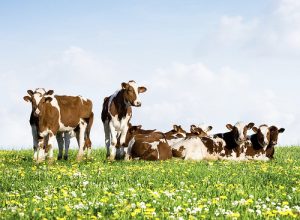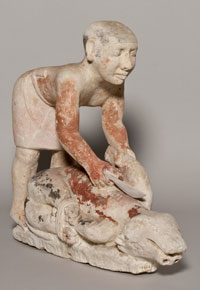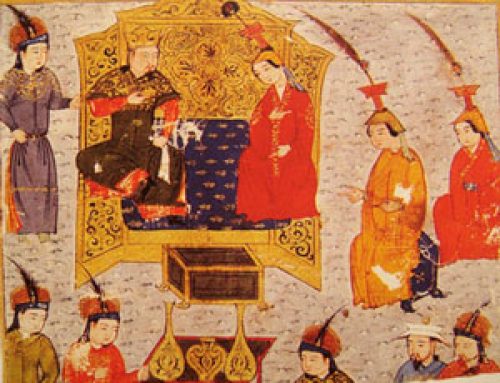
History of cows: Cows in a field
The wild auroch
Cattle are the tame version of the wild aurochs that used to live on the grass plains of Asia, Africa, and Europe.
What is an aurochs?
Evolution of mammals
All our biology articles
About 7000 BC, people in North Africa began to keep tame cattle. Berber herders walked from place to place, around the grasslands with their cattle, keeping moving so there would be enough grass for their herds to eat. They moved further south in the winter, and further north in the summer. People chose which aurochs to breed, so that they evolved into a slower, stupider, tamer, smaller animal we call cattle.
More about North Africa
All our Africa articles
About 5000 BC, people in Central Asia did the same thing. At first people just kept cattle for their meat and leather, but soon they also got milk from cows, and they started to make yogurt and cheese. By about 4000 BC, people also began to use cattle as oxen, to pull plows and wagons.
More about leather
Who invented cheese?

History of cows: Ancient Egyptian cattle plowing (Louvre Museum, Paris)
Bulls, cows, steers, oxen
We call male cattle bulls, and female cattle cows. Bulls are dangerous, and we don’t need very many of them, so people keep most male cattle from having babies – those bulls that can’t have babies are steers.
What is a plow?
Cattle that work hard plowing or pulling wagons, like the two that are plowing a field in this Egyptian model, we call oxen. Most oxen are steers.
Central Asia and South Africa
By the Bronze Age, a lot of people kept cattle in Central Asia, where the wide plains grew plenty of grass for the cattle to eat. Some of these people are the Scythians, the Yamnaya, the Huns, and the Mongols.
Who are the Scythians?
Central Asian Environment
More about the Mongols
South of the Sahara desert, a lot of people kept cattle also. Cattle were very important to the people of Meroe south of Egypt and across the Sudan, and cattle were also very important to the KhoiKhoi and the San in South Africa.
Meroe and Kush
And in later Sudan
The KhoiKhoi and the San
Herders in Chad
None of these people used cattle to farm. Instead, like the people of Central Asia, people in Africa ate beef and drank milk.

History of cows: Egyptian butcher cuts a calf’s neck (Old Kingdom, now in Oriental Institute, Chicago)
West Asia and India
The Mediterranean, West Asia, and India are none of them good places for cattle. They are too dry, and there is not enough grass. These places are better suited for sheep or water buffalo.
Hinduism
More about sheep
People kept only a few cattle for heavy work like plowing. In India, people mostly used water buffalo for plowing and for milk and yogurt. They didn’t eat cows or water buffalo because Hindus believed cows were sacred.

History of cows: Oxen from Tang Dynasty China
China
In China, people also plowed with oxen.
Farming in China
In Northern China they used the same oxen as in West Asia, and in Southern China they used water buffalo, as people did in India.
Native Americans and bison
In North America, people did not use domesticated (tame) cattle for plowing, but they did hunt and eat wild cattle called bison.
More about bison
North American environment
When people from Europe came to America, about 1600 AD, they brought their domesticated (tame) cattle with them, and by the 1800s AD there were many oxen plowing fields in both North and South America, and many more grazing on the pastures of the American plains, being herded by cowboys, replacing the buffalo which Europeans had mostly killed.
Cows in modern times
In most of the world, even today, oxen are still important today for farming and transportation. But by the early 1900s AD, people in North America and Europe started to use tractors and trucks instead of oxen for heavy work.
What is global warming?
Today we keep cattle mainly for milk and cheese and beef and leather. In richer countries, people today eat much more milk and meat than they used to, and cattle raised for milk and meat are a major cause of global warming.
Learn by doing: Visit a dairy farm and see cows
Or make yogurt
More about the aurochs
More about buffalo
Bibliography and further reading about cattle:
Cattle, by Dorothy Hinshaw Patent (1993). Easy reading.
Cows, by Sara Swan Miller (2000). Also easy reading. Only deals with dairy cows, so you don’t have to confront the fact that people kill cows and eat them. There is a bit on Indian sacred cows, though.
A Natural History of Domesticated Mammals, by Juliet Clutton-Brock (2nd edition 1999). Mainly deals with how cattle (and other animals) got tamed, so people could raise them. A little harder to read.




